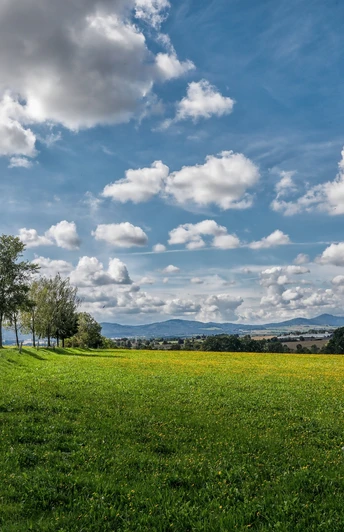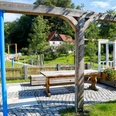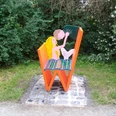- Photos & Map
How would you like to arrive?
- Description
- Good to know
- Nearby
Download GPX file
- 1:10 h
- 4.61 km
- 63 m
- 63 m
- 251 m
- 314 m
- 63 m
- Start: Village experience square Eckartsberg
- Destination: Village experience square Eckartberg
Based on the parcel size and boundaries, it is assumed that the village existed before the eastward colonization. Eckardistorph was first mentioned in writing in 1310. At that time, the St. Marienthal monastery owned several farms, the others belonged to Heinrich von Leipa. The village was probably named after a locator named Eckhard. With the rise of the city of Zittau, several farms were gradually acquired by wealthy Zittau citizens. At the beginning of the 16th century, the council of Zittau also took over the Marienthal share; thus the entire village belonged to it. With a short interruption due to the Upper Lusatian Pönfall, Eckartsberg remained one of the Zittau council villages, but the St. Marienthal monastery still conducted a lawsuit with the city over property claims in Eckartsberg in 1618. The Schleekretscham, located in the Eckartsbach gorge in the northwest part of the village, has been documented since 1560 in connection with a "Schleerichter am Berge"; nearby, an unsuccessful ore mining attempt took place in the second half of the 16th century. From the tunnel, the "Kuxloch," a wooden water conduit has led since 1599 to the Eckartsberg manor and from there to Zittau. The council of Zittau had the Eckartsberg water conduit renewed in 1682 and 1722 and expanded with new water facilities at the Hasenberg farms. In 1676, the Schleemühle was built at the Schleekretscham.
Since the 18th century, Zittau citizens built summer houses on the slope towards the Eckartsbach; this trend continued until the mid-19th century, after which they preferred the Zittau Mountains. Unlike most other Zittau council villages, only a few weavers settled in Eckartsberg during the 18th century. Residents of the village were mainly farmers, craftsmen, and day laborers. The Schleekretscham developed at the turn from the 18th to the 19th century into a well-known social venue beyond the local borders. The old Zittau-Herrnhut road leading through the Eckartsbach gorge at Schleekretscham was expanded between 1826 and 1827 to a high military and country road, along which the houses known as "Vierhäuser" were established. Brown coal extraction began in the Eckartsbach floodplain at the foot of the Hasenberg in 1843. Brown coal mining was expanded in the second half of the 19th century; in addition to the "Braunkohlenwerk zum Schlösschen" and the "Gerlach'sches Braunkohlenwerk," other mines were established on the adjacent Zittau Hasenberg fields, where Zittau citizens and craftsmen mined coal in mostly small shaft systems, disregarding safety. Several fatal accidents occurred in the "Braunkohlenwerk zum Schlösschen" in the 1860s. A quarry was established behind the Schleekretscham in the mid-19th century, where basalt balls were extracted and processed into ballast for road and railway construction. In close proximity to the quarry, the paper tube factory of Alfred Hübner GmbH was established in 1911 on the Zittau-Löbau road; no further industrial settlements followed. Eckartsberg was always assigned to the parish of Zittau.
The basalt plant was closed in the second half of the 20th century. The paper mill located between the entrances to the basalt works and the Schleekretscham formed the production area for paper tubes of the VEB paper processing plant Zittau during the GDR period. The Eckartsberg farmers were collectivized into the LPG "Aufstieg" in 1953, which managed 285 ha. In 1960, the Oberhasenberg estate merged with the two Zittau Hasenberg farms into the "GPG Hasenberg," which cultivated field vegetables on 45 ha north of Zittau extending to Weinau. Radgendorf was incorporated in 1965. After the political change, the industrial area "Zittau Nord/Ost" was created at the southeastern end of Eckartsberg in the 1990s, which covers about 20% of the Eckartsberg district with 110 ha. Since the privatisation in 1991, the paper tube factory operates as Eckartsberger Papierverarbeitung GmbH. On March 1, 1994, Mittelherwigsdorf, Oberseifersdorf, and Eckartsberg merged into a large municipality Mittelherwigsdorf. Since 2000, the Zittau northern bypass of federal highway 178 runs north of the village.
Good to know
Pavements
Best to visit
Directions
From the village experience square, it goes along Geschwister-Scholl-Straße towards Zittau. After a few minutes, we see on our right side the oldest house in Eckartsberg, the "Alte Lotte." We continue following the street, passing the former inn "Zum Eichenwäldchen" until the street makes a slight bend to the right. There we turn sharply left and stay on the lower street. If you were to go up the street to the right, you would come to the "Sonnenblume" kindergarten and a community garden. However, we stay on Feldstraße and see straight ahead a four-sided farm. This includes three beautiful holiday apartments. We now continue past the cow pastures and can enjoy a magnificent view of the Zittau and Jeschken Mountains. The local history museum on the left invites you to linger. Continuing along Feldstraße, we reach a viewpoint bench with a panorama board. We follow the street and keep left, passing pastures, views, and farms. At a large oak tree, we turn left and go down Bergstraße to the right turn into "Zum Steinbruch" street. We continue along this and pass the diving club and former quarry. Crossing the Eckartsbach over a large stone bridge, we keep left on the foot and bike path next to the B178. Passing the garden plot "Schleekrtscham," we head back towards the town center. At the bus stop "Eckartsberg Löbauer Straße," we turn right and pass the so-called five houses.
Following stations:
- Village experience square Eckartsberg
- Half-timbered house: Geschwister-Scholl-Straße 79
- Luther oak
- Eckartsberg local history association e.V.
- Panorama view Eckartsberg
- Kaiser's oak
- Quarry Eckartsberg
- Five houses
Tour information
Loop Road
Suitable for Pushchair
Equipment
Directions & Parking facilities
You can reach Oberseifersdorf using the following transport connections:
- B178 from the direction of Löbau or Zittau
Eckartsberg can be reached hourly Monday to Friday by line +10 of KVG Dreiländereck, coming from Löbau or Zittau. On Saturdays and Sundays, the line runs every 2 hours.
Also, line 18 runs hourly Monday to Friday from Zittau to Mittelherwigsdorf via Oberseifersdorf, Eckartsberg, Radgendorf as a circular service.
http://www.kvg-zittau.de/fahrplaene/fahrplaene.htm
From the bus stop Eckartsberg Löbauer Straße, it is only about a 10-minute walk to the village experience square.
Additional information
For further information about the village route and half-timbered house street, Mr. Plüschke from the municipal administration is available at 03583/501314.
Please also visit the municipality of Mittelherwigsdorf's website: https://www.mittelherwigsdorf.de/
Literature
If you want to learn more about the district of Eckartsberg, the village book Eckartsberg is recommended. You can purchase it at the municipal administration of Mittelherwigsdorf, Am Gemeindeamt 7, 02763 Mittelherwigsdorf.
Author
Gemeinde Mittelherwigsdorf
Organization
Das Landschaftswunderland Oberlausitz
License (master data)
Author´s Tip / Recommendation of the author
The Eckartsberg local history association invites you with its historically designed three-sided farm to the Eckartsberg village museum. There you can learn more about agriculture, rural life, and changing exhibitions.
Another highlight of this route is the "Alte Lotte" along the village circuit. The oldest house in Eckartsberg is being developed by the fire brigade and historical association into a multi-generation village community house and looks forward to your visit.
Nearby






